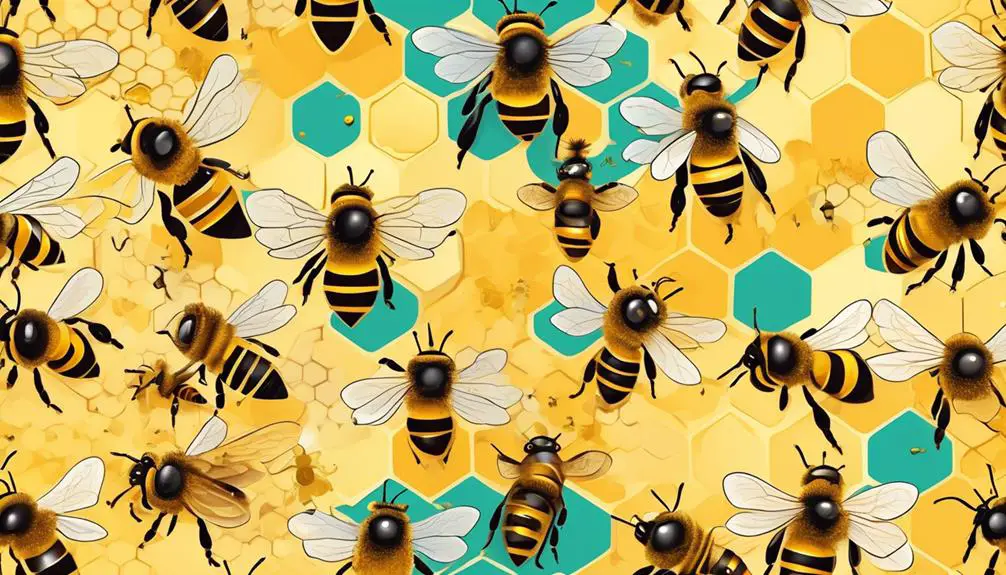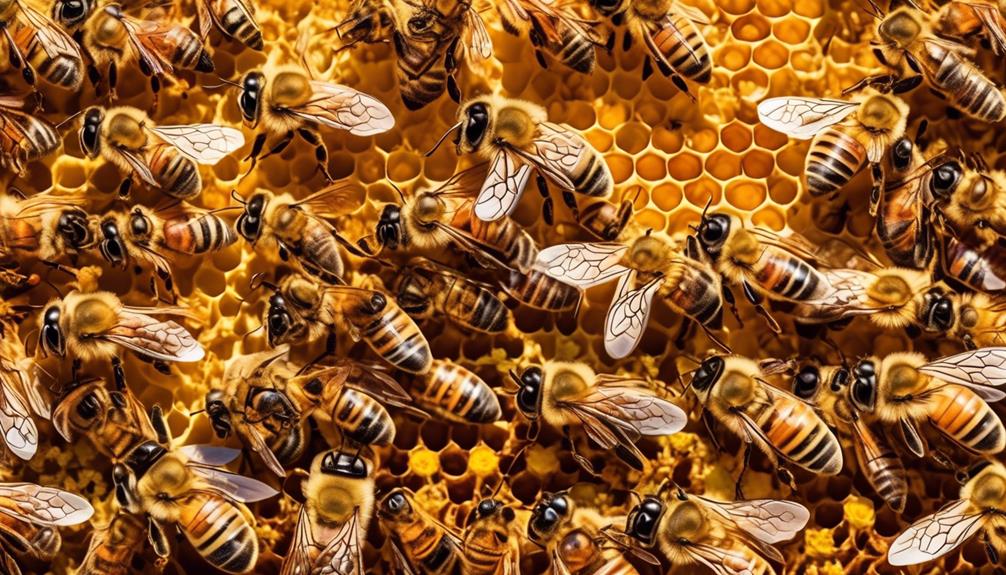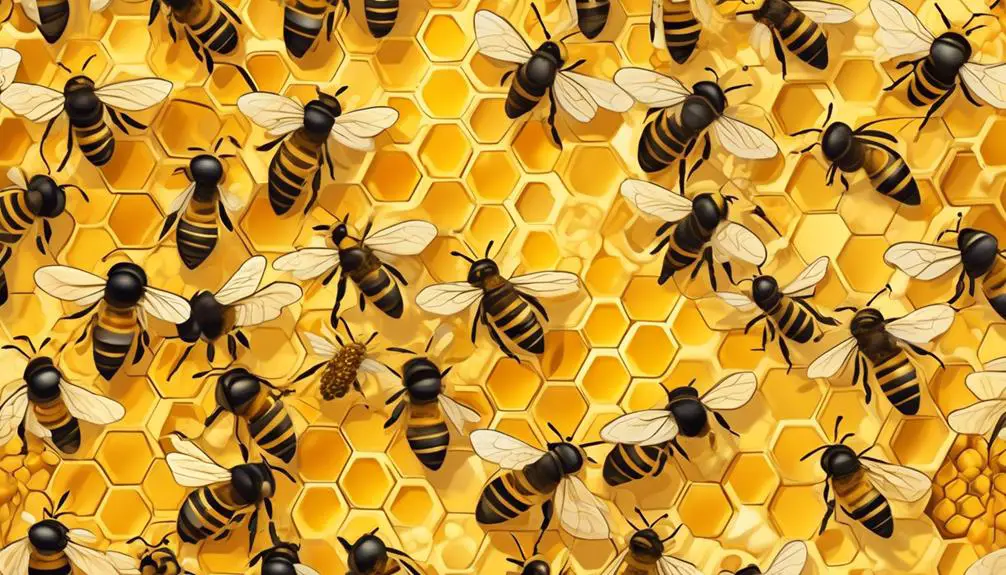Uncover the surprising gender dynamics of honey bee hives and delve into the intriguing roles of male and female worker bees.

Are Honey Bee Workers Male or Female
Imagine you're observing a bustling beehive, teeming with activity, and you can't help but wonder – are all these busy workers male or female?
You'd be surprised to find out that the industrious bees you see collecting nectar and building the hive are all females. Yes, that's right! The worker bees, which make up the majority of the hive's population, are indeed female.
But why are they all female and what role do the males play in the beehive? Well, that's a fascinating tale of nature's intricate design that would certainly pique your interest.
Key Takeaways
- Female worker bees are the backbone of the hive, responsible for various essential tasks such as tending to larvae, foraging for food, and maintaining hive cleanliness.
- The genetic mechanism haplodiploidy determines bee sex, with worker bees being females, highlighting their crucial role in hive balance and efficiency.
- Drones, which are male bees, do not contribute to hive maintenance or defense but focus solely on reproduction by mating with new queens.
- Worker bees have hind legs with pollen baskets, while drones are larger with a rounded abdomen and lack stingers, aiding in the identification of male and female bees within the hive.
Understanding Honey Bee Colonies

In unraveling the intricacies of honey bee colonies, you'll discover a complex, hierarchical society primarily composed of female worker bees, each performing vital roles that sustain the hive's function and survival. You'll find that these industrious females are the backbone of the colony, tending to larvae, foraging for food, and keeping the hive clean and organized.
However, it's not just a matter of hard work. The female worker bees' roles are intricately linked to their physiological development, dictated by a fascinating process of genetic determination. In honey bee colonies, sex is determined by a unique system called haplodiploidy. Females, including both workers and the queen, are diploid, meaning they're produced from fertilized eggs and have two sets of chromosomes. Males, or drones, on the other hand, are haploid and arise from unfertilized eggs, possessing only a single set of chromosomes.
This genetic mechanism has profound implications for the social structure and survival of the hive. It not only designates the worker bees' gender but also influences their behavior, task allocation, and the overall dynamic within the colony. You'll see that the worker bees' female identity is integral to the intricate balance and efficiency of the hive.
Roles of Bees in a Hive

Diving deeper into the hive, you'll encounter bees fulfilling diverse roles, each crucial to the survival and prosperity of their colony. Within this organized chaos, you'll find three primary roles: the queen, the workers, and the drones.
The queen, the only fertile female, has a singular purpose: to lay eggs. She's the mother of all bees in the hive, laying up to 2,000 eggs a day to ensure the colony's future.
Then, there are the worker bees. They're all females but typically don't reproduce. Instead, they carry out the tasks necessary for the colony's survival. They gather food, maintain the hive, care for the young, and defend the colony. Their roles change as they age, a phenomenon known as temporal polyethism.
Lastly, the drones. These are the males of the hive, their primary role being to mate with a new queen. They don't contribute to the maintenance or defense of the hive.
Understanding these roles allows you to appreciate the intricate social structure of a beehive, a testament to nature's complexity and efficiency.
Identifying Male and Female Bees

You'll find that distinguishing between male and female bees isn't as difficult as you might think, once you understand the key physical differences and behaviors.
Male bees, or drones, are larger than their female counterparts and possess a more rounded abdomen. Drones also lack stingers, a defining characteristic of female worker bees and queens. This physical trait makes drones harmless to humans. Moreover, drones have larger and more robust eyes, which they use for spotting queens during the mating flight.
On the other hand, female bees, both workers and queens, have a more streamlined body shape and are equipped with a stinger for defense. Worker bees are smaller and their hind legs have special structures, called pollen baskets, for carrying pollen. Queens, while also female, are larger and longer than both drones and workers.
Behavior-wise, drones are typically more lethargic and can often be seen aimlessly flying around the hive, whereas worker bees are always busy collecting nectar and pollen, cleaning the hive, or taking care of larvae. Understanding these differences will help you identify the gender of bees with ease.
Facts About Female Worker Bees

Having understood how to distinguish between male and female bees, let's now explore some intriguing facts about female worker bees, the diligent and versatile members of a honey bee colony.
You might be surprised to learn that these industrious insects do virtually all the work within the hive. They're involved in a variety of tasks, including cleaning, feeding the brood, taking care of the queen, producing wax, building combs, foraging for nectar and pollen, as well as defending the hive.
Furthermore, worker bees are essentially sterile females, though they possess the necessary apparatus for laying eggs. However, under certain circumstances, such as the death or absence of the queen bee, a worker can lay unfertilized eggs that develop into drones or male bees.
Interestingly, the lifespan of a worker bee varies greatly depending on the time of year she's born. Those born in spring or summer usually live for 6 weeks, while those born in the fall can live through the winter, which can be up to 5-6 months.
Certainly, the role and life of a worker bee is far more complex and fascinating than one might initially think.
The Purpose of Male Bees

Often overlooked, male bees, also known as drones, play a vital but singular role in the lifecycle of a honey bee colony which is centered around mating with the queen. You might wonder, 'What's the purpose of male bees?' Simply put, their primary function is to fertilize the queen bee.
Unlike worker bees, drones don't have stingers and don't participate in nectar and pollen gathering. A drone's sole responsibility is to mate with an unfertilized queen. In fact, their anatomy is specifically designed for this task. Drones have larger eyes, which they use to spot queens during mating flights. They also have larger bodies, which are necessary to support the energy required for these flights.
However, mating is a fatal event for drones. After mating, they die immediately because their reproductive organ and associated abdominal tissues are torn from their bodies. Even those drones that don't mate will be driven out of the hive to die, as they're considered a drain on resources over winter. Consequently, the drone's contribution, though brief, is crucial to the survival of the hive. Their genetic material helps ensure the diversity and survival of the next generation of bees.
Conclusion
In unraveling the mystery of honey bee colonies, you've discovered that worker bees are indeed females, tirelessly fulfilling crucial roles for the hive's survival.
Males, or drones, serve a singular purpose – mating with the queen.
The fascinating, complex structure of bee societies illustrates the vital importance of each member's contribution.
Understanding this intricate balance underscores the need to protect these remarkable, industrious insects, our invaluable partners in pollination.



